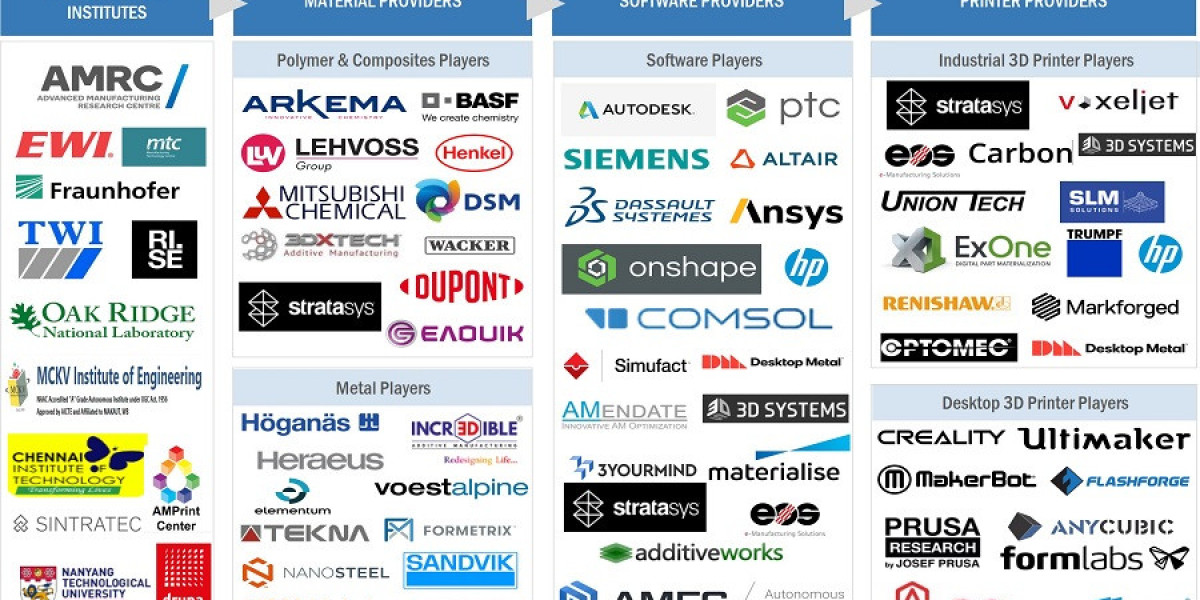The 3D printing industry has witnessed significant growth in recent years, transforming various sectors by enabling faster production, customized products, and even reducing environmental footprints. It is a technology that allows the creation of three-dimensional objects from digital files by laying down successive layers of material. With its applications spanning industries such as healthcare, aerospace, automotive, and manufacturing, 3D printing is redefining traditional production processes.
In 2024, the global 3D printing industry is estimated to be USD 17.5 billion and is projected to reach USD 37.4 billion by 2029, growing at a Compound Annual Growth Rate (CAGR) of 16.4% during the forecast period from 2024 to 2029. This article explores the key aspects of the 3D printing industry, examining its market trends, innovations, challenges, and future prospects.
Segmentation of the 3D Printing Industry
The 3D printing industry is segmented into different applications and materials. Key sectors include:
- Aerospace: 3D printing helps reduce part weight and increase fuel efficiency.
- Healthcare: It enables customized prosthetics, implants, and tissue engineering.
- Automotive: The automotive industry utilizes 3D printing for prototyping and production of lightweight components.
- Manufacturing: 3D printing streamlines the production of complex parts.
Materials such as plastics, metals, ceramics, and even biocompatible materials are widely used in 3D printing, each serving different industry needs.
Trends and Innovations in the 3D Printing Industry
3D Printing in Healthcare
3D printing in healthcare is advancing rapidly, with applications ranging from customized medical devices to bioprinting tissues. The technology allows for the creation of patient-specific implants and prosthetics, which significantly improves the quality of care. Additionally, 3D printing holds promise for printing functional human tissues, making it an exciting area for future medical advancements.
3D Printing in Aerospace and Automotive
In the aerospace and automotive industries, 3D printing is being used to create lightweight components, reducing fuel consumption and costs. The ability to rapidly prototype and produce customized parts has led to faster development cycles and more efficient manufacturing processes.
Key Players in the 3D Printing Industry
Several companies are leading the way in the 3D printing market, including:
- Stratasys: Known for its high-quality 3D printing systems used in industries such as aerospace and healthcare.
- 3D Systems: A pioneer in the additive manufacturing space, offering solutions for various sectors.
- HP: A major player in 3D printing, particularly in the area of industrial production.
These companies, along with others, are pushing the boundaries of what is possible with 3D printing, fostering new applications and capabilities.
Benefits and Challenges of 3D Printing
Benefits
- Customization: 3D printing allows for highly customized products, tailored to specific needs.
- Cost-Efficiency: The ability to produce parts on-demand reduces waste and lowers manufacturing costs.
- Supply Chain Optimization: 3D printing helps streamline supply chains by enabling localized production.
Challenges
- Material Limitations: Not all materials are suitable for 3D printing, and the range of printable materials is still expanding.
- Scalability: While 3D printing is excellent for prototyping, scaling up production can be challenging.
- Regulatory Concerns: The rapid adoption of 3D printing in industries like healthcare brings with it the need for regulatory oversight.
Future of the 3D Printing Industry
The future of the 3D printing industry looks bright, with continued technological advancements expected to drive even more widespread adoption. Emerging innovations such as 3D printing in construction, food production, and space exploration suggest that the potential of this technology is far from being fully realized.
Download PDF Brochue @ https://www.marketsandmarkets.com/pdfdownloadNew.asp?id=1276
3D Printing in Smart Manufacturing
As part of Industry 4.0, 3D printing is playing an important role in smart manufacturing by integrating with the Internet of Things (IoT) and automation technologies. This integration leads to more efficient, data-driven production processes.
The 3D printing industry is on a trajectory of impressive growth, with innovations in materials, technologies, and applications pushing it into new realms. As industries continue to adopt this transformative technology, the potential for further breakthroughs remains high. The future of the 3D printing industry promises even greater efficiency, sustainability, and customization, making it an exciting space to watch in the coming years.
FAQs
1. What industries benefit from 3D printing? 3D printing is used in aerospace, automotive, healthcare, manufacturing, and consumer products industries for rapid prototyping, custom production, and lightweight component manufacturing.
2. What is the expected market growth for 3D printing? The global 3D printing market is expected to grow from USD 17.5 billion in 2024 to USD 37.4 billion by 2029, with a CAGR of 16.4%.
3. What are the different types of 3D printing technologies? Key technologies include FDM, SLA, and SLS, each offering unique advantages for specific applications.
4. How does 3D printing benefit the healthcare sector? 3D printing enables the production of patient-specific medical devices, implants, and prosthetics, offering more personalized healthcare solutions.
5. What are the challenges of 3D printing? Challenges include material limitations, scalability issues, and regulatory hurdles, particularly in industries like healthcare.
6. What is the role of AI in 3D printing? AI enhances the 3D printing process by optimizing designs, improving material use, and automating production.








